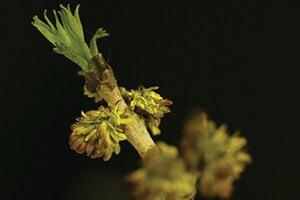
Scientific name: Fraxinus americana
Synonyms: Fraxinus biltmoreana
Origin: North America
Plant description: Fraxinus americana is a large tree generally in the range of 15 to 24 m (~50 to 79 ft high) and 60 to 100 cm (~24in to 39 in) in diameter. It can, however, be somewhat larger. Dirr[4] indicates that the national champion at the time of his writing was 95 ft (~29 m) tall and mentions that the trees can grow to 120 ft (~37 m) in height.
The bark is gray and deeply furrowed into narrow regularly flattened interlacing ridges that give the impression of a diamond pattern.
The leaves are pinnately compound1 and are made up of 6 to 8 oppositely placed leaflets plus a terminal leaflet (see photo of a single leaf made up of 6 paired leaflets and its terminal leaflet in the margin). The leaves are placed opposite each other and are 20 to 38 cm (~8 to 15 in) long. The leaflets are 7 to 13 cm (~2.8 to 5.1 in) long and 2.5 to 5 cm (~0.98 to 2in) wide and are attached to the central ‘leaf stem’ by short stems. The leaflets range in shape from ovate2 to oblong lanceolate and are without teeth or are obscurely serrated around their edge. They are relatively thick and firm, dark green above and conspicuously paler, even whitish beneath. The leaf stems are hairless, stout and grooved.
The twigs are stout and without hairs. They are at first dark green but become gray or brownish. The leaf scars where the leaves were once attached are raised at an angle and give the twigs a knobby appearance. Except for this year’s shoot, the epidermis (outer twig layer) forms a loose, flaking or peeling, waxy covering or membranous strips. The areas where the leaves were once attached (leaf scar) are sometimes deeply notched on the top. Within the leaf scar, there are a number of bundle scars where the transport system (small tubes) responsible for carrying nutrients to the leaf have been broken. They lie in a u-shaped pattern.[2]
Distribution: The plants.usda.gov website[13] indicates by my count that there are 22 species of the genus Fraxinus growing in North America. Think of the map provided here as being the distribution of the total number of Fraxinus species of North America upon which the green area representing the distribution of Fraxinus americana has been superimposed. Other species would also exist within this green area. The brownish green area represents the residual areas in which species other than Fraxinus americana grow. Idaho appears to represent an anomaly for which this writer has no explanation.
Ash is not prominently mentioned in the beekeeping literature. It did however show up in the questionnaires sent out by Ayers and Harman[1] upon which the large table found in both the 1992 and 2015 editions of The Hive and the Honey Bee is based. It is also found in the extensive questionnaire returns that Oertel[9] reported on that identified Fraxinus americana as being of some importance in IL, and Fraxinus campestris (now Fraxinus pennsylvanica) as being of some importance in NE, and just the genus to be of some importance in CO, NH, NJ, UT and WA.
The beekeeping literature frequently uses only …
Photo Caption
Fraxinus Americana male flowers. Photo taken at the W. J. Beal Botanical Garden on the Michigan State University campus on 4/26/2016. Notice the large amounts of pollen which can best be seen on the right-hand side of the twig as a bright yellow coloration. The photo makes it clear why the pollen loads of bees visiting Fraxinus are sometimes featured in the beekeeping literature. The text provided in this writing suggests that nectar is probably in short supply.


